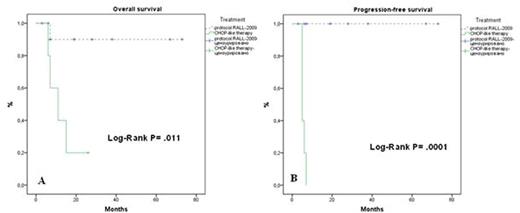Abstract
Introduction: Angioimmunoblastic T-cell lymphoma (AITL) is characterized by low response rate to standard therapy and relapses in the course of treatment. CHOP-like therapy shows 70-80 % of overall response rate, though 2-year progression-free survival is observed only in 30-40 % of patients. Older patients are more frequently diagnosed with AITL than younger subjects. Usually the median age of those patients is 60 years. A search for new approaches to treatment of AITL has an important medical and social aspect.
Aim: The aim of our study is to define rational approaches to treatment of younger patients with AITL, to assess the overall and progression-free survival depending on the type of therapy.
Patients and methods: 45 patients with AITL were treated between 2002 and 2016 in our center. The diagnosis was verified according to WHO classification. We analyzed clinical outcomes in 17 (38%) patients younger than 55 years treated by different protocols.
Results: Of 17 patients there were 9 men and 8 women with a median age of 41 (range, 29-55) years. 14 of 17 patients had Ann Arbor stage IV. Bone marrow involvement was detected in 7 of 17 cases by histological tests. Lung involvement was observed in 10 cases. B symptoms and elevated LDH level were present in all patients. Despite the younger age of the patients, 12 of 17 were classified as having an intermediate-high (n=5) and high (n=7) risk IPI score. There were 5 of 17 patients, who received CHOP-like therapy; other 12 patients were treated by longed therapy. There were 4 of 5 patients after CHOP-like therapy, who showed the progression from 1 to 4 (median 2) months, one achieved partial remission. There were 12 of 17 patients who were treated by the longed therapy according to RALL-2009 protocol (ClinicalTrials.gov public site; NCT01193933), successfully used for treatment of acute lymphoblastic leukemia in Russia. The program is based on non-intensive but uninterrupted treatment. After induction + consolidation phases (150 days) patients received maintenance therapy by interferon-A and thalidomide over 2 years. All 12 patients achieved complete remission, none of them showed disease progression. Two patients received autologous stem cell transplant (Auto-SCT) as first line consolidation treatment, conditioning regimen was CEAM (CCNU, etoposide, Ara-C, melphalan). One patient died after Auto-SCT from infection complications without disease progression. 11 (92%) of 12 patients treated by RALL-2009 protocol are alive, follow-up survival varies from 3 to 73 (median 19) months. A univariate analysis of overall and progression-free survival curves showed that longed therapy is more effective than CHOP-like therapy (Fig.1).
Conclusion: Though, the study is small, the results show that higher efficiency of RALL-2009 protocol than CHOP-like therapy in younger patients withAITL. It is particularly important for working patients. The principle of non-intensive but uninterrupted usage cytostatic drugs and longed maintenance therapy by immunomodulators allows to avoid the early treatment failures and provides optimistic long-term results.
(A) Overall and (B) progression-free survival of younger patients with AITL depending on the type of therapy.
(A) Overall and (B) progression-free survival of younger patients with AITL depending on the type of therapy.
No relevant conflicts of interest to declare.
Author notes
Asterisk with author names denotes non-ASH members.


